door lock Seat Mii 2016 Owner's manual
[x] Cancel search | Manufacturer: SEAT, Model Year: 2016, Model line: Mii, Model: Seat Mii 2016Pages: 232, PDF Size: 4.9 MB
Page 5 of 232
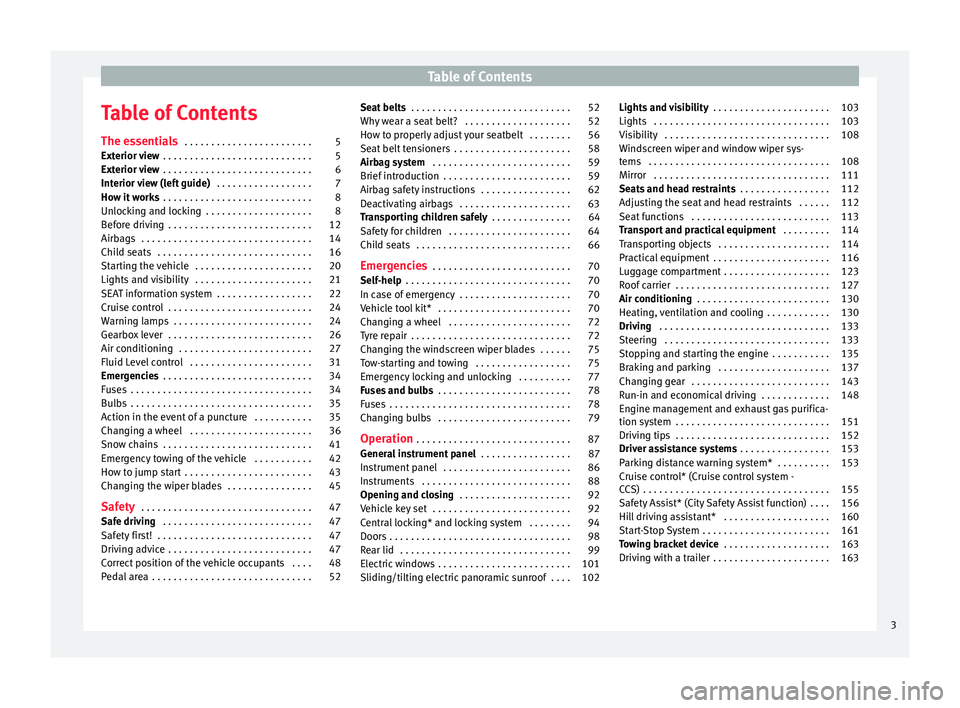
Table of Contents
Table of Contents
The e s
senti
als . . . . . . . . . . . . . . . . . . . . . . . . 5
Exterior view . . . . . . . . . . . . . . . . . . . . . . . . . . . . 5
Exterior view . . . . . . . . . . . . . . . . . . . . . . . . . . . . 6
Interior view (left guide) . . . . . . . . . . . . . . . . . . 7
How it works . . . . . . . . . . . . . . . . . . . . . . . . . . . . 8
Unlocking and locking . . . . . . . . . . . . . . . . . . . . 8
Before driving . . . . . . . . . . . . . . . . . . . . . . . . . . . 12
Airbags . . . . . . . . . . . . . . . . . . . . . . . . . . . . . . . . 14
Child seats . . . . . . . . . . . . . . . . . . . . . . . . . . . . . 16
Starting the vehicle . . . . . . . . . . . . . . . . . . . . . . 20
Lights and visibility . . . . . . . . . . . . . . . . . . . . . . 21
SEAT information system . . . . . . . . . . . . . . . . . . 22
Cruise control . . . . . . . . . . . . . . . . . . . . . . . . . . . 24
Warning lamps . . . . . . . . . . . . . . . . . . . . . . . . . . 24
Gearbox lever . . . . . . . . . . . . . . . . . . . . . . . . . . . 26
Air conditioning . . . . . . . . . . . . . . . . . . . . . . . . . 27
Fluid Level control . . . . . . . . . . . . . . . . . . . . . . . 31
Emergencies . . . . . . . . . . . . . . . . . . . . . . . . . . . . 34
Fuses . . . . . . . . . . . . . . . . . . . . . . . . . . . . . . . . . . 34
Bulbs . . . . . . . . . . . . . . . . . . . . . . . . . . . . . . . . . . 35
Action in the event of a puncture . . . . . . . . . . . 35
Changing a wheel . . . . . . . . . . . . . . . . . . . . . . . 36
Snow chains . . . . . . . . . . . . . . . . . . . . . . . . . . . . 41
Emergency towing of the vehicle . . . . . . . . . . . 42
How to jump start . . . . . . . . . . . . . . . . . . . . . . . . 43
Changing the wiper blades . . . . . . . . . . . . . . . . 45
Safety . . . . . . . . . . . . . . . . . . . . . . . . . . . . . . . . 47
Safe driving . . . . . . . . . . . . . . . . . . . . . . . . . . . . 47
Safety first! . . . . . . . . . . . . . . . . . . . . . . . . . . . . . 47
Driving advice . . . . . . . . . . . . . . . . . . . . . . . . . . . 47
Correct position of the vehicle occupants . . . . 48
Pedal area . . . . . . . . . . . . . . . . . . . . . . . . . . . . . . 52 Seat belts
. . . . . . . . . . . . . . . . . . . . . . . . . . . . . . 52
Why wear a seat belt? . . . . . . . . . . . . . . . . . . . . 52
How to properly adjust your seatbelt . . . . . . . . 56
Seat belt tensioners . . . . . . . . . . . . . . . . . . . . . . 58
Airbag system . . . . . . . . . . . . . . . . . . . . . . . . . . 59
Brief introduction . . . . . . . . . . . . . . . . . . . . . . . . 59
Airbag safety instructions . . . . . . . . . . . . . . . . . 62
Deactivating airbags . . . . . . . . . . . . . . . . . . . . . 63
Transporting children safely . . . . . . . . . . . . . . . 64
Safety for children . . . . . . . . . . . . . . . . . . . . . . . 64
Child seats . . . . . . . . . . . . . . . . . . . . . . . . . . . . . 66
Emergencies . . . . . . . . . . . . . . . . . . . . . . . . . . 70
Self-help . . . . . . . . . . . . . . . . . . . . . . . . . . . . . . . 70
In case of emergency . . . . . . . . . . . . . . . . . . . . . 70
Vehicle tool kit* . . . . . . . . . . . . . . . . . . . . . . . . . 70
Changing a wheel . . . . . . . . . . . . . . . . . . . . . . . 72
Tyre repair . . . . . . . . . . . . . . . . . . . . . . . . . . . . . . 72
Changing the windscreen wiper blades . . . . . . 75
Tow-starting and towing . . . . . . . . . . . . . . . . . . 75
Emergency locking and unlocking . . . . . . . . . . 77
Fuses and bulbs . . . . . . . . . . . . . . . . . . . . . . . . . 78
Fuses . . . . . . . . . . . . . . . . . . . . . . . . . . . . . . . . . . 78
Changing bulbs . . . . . . . . . . . . . . . . . . . . . . . . . 79
Operation . . . . . . . . . . . . . . . . . . . . . . . . . . . . . 87
General instrument panel . . . . . . . . . . . . . . . . . 87
Instrument panel . . . . . . . . . . . . . . . . . . . . . . . . 86
Instruments . . . . . . . . . . . . . . . . . . . . . . . . . . . . 88
Opening and closing . . . . . . . . . . . . . . . . . . . . . 92
Vehicle key set . . . . . . . . . . . . . . . . . . . . . . . . . . 92
Central locking* and locking system . . . . . . . . 94
Doors . . . . . . . . . . . . . . . . . . . . . . . . . . . . . . . . . . 98
Rear lid . . . . . . . . . . . . . . . . . . . . . . . . . . . . . . . . 99
Electric windows . . . . . . . . . . . . . . . . . . . . . . . . . 101
Sliding/tilting electric panoramic sunroof . . . . 102 Lights and visibility
. . . . . . . . . . . . . . . . . . . . . . 103
Lights . . . . . . . . . . . . . . . . . . . . . . . . . . . . . . . . . 103
Visibility . . . . . . . . . . . . . . . . . . . . . . . . . . . . . . . 108
Windscreen wiper and window wiper sys-
tems . . . . . . . . . . . . . . . . . . . . . . . . . . . . . . . . . . 108
Mirr
or . . . . . . . . . . . . . . . . . . . . . . . . . . . . . . . . . 111
Seats and head restraints . . . . . . . . . . . . . . . . . 112
Adjusting the seat and head restraints . . . . . . 112
Seat functions . . . . . . . . . . . . . . . . . . . . . . . . . . 113
Transport and practical equipment . . . . . . . . . 114
Transporting objects . . . . . . . . . . . . . . . . . . . . . 114
Practical equipment . . . . . . . . . . . . . . . . . . . . . . 116
Luggage compartment . . . . . . . . . . . . . . . . . . . . 123
Roof carrier . . . . . . . . . . . . . . . . . . . . . . . . . . . . . 127
Air conditioning . . . . . . . . . . . . . . . . . . . . . . . . . 130
Heating, ventilation and cooling . . . . . . . . . . . . 130
Driving . . . . . . . . . . . . . . . . . . . . . . . . . . . . . . . . 133
Steering . . . . . . . . . . . . . . . . . . . . . . . . . . . . . . . 133
Stopping and starting the engine . . . . . . . . . . . 135
Braking and parking . . . . . . . . . . . . . . . . . . . . . 137
Changing gear . . . . . . . . . . . . . . . . . . . . . . . . . . 143
Run-in and economical driving . . . . . . . . . . . . . 148
Engine management and exhaust gas purifica-
tion syst
em . . . . . . . . . . . . . . . . . . . . . . . . . . . . . 151
Driving tips . . . . . . . . . . . . . . . . . . . . . . . . . . . . . 152
Driver assistance systems . . . . . . . . . . . . . . . . . 153
Parking distance warning system* . . . . . . . . . . 153
Cruise control* (Cruise control system -
CCS)
. . . . . . . . . . . . . . . . . . . . . . . . . . . . . . . . . . . 155
Safety Assist* (City Safety Assist function) . . . . 156
Hill driving assistant* . . . . . . . . . . . . . . . . . . . . 160
Start-Stop System . . . . . . . . . . . . . . . . . . . . . . . . 161
Towing bracket device . . . . . . . . . . . . . . . . . . . . 163
Driving with a trailer . . . . . . . . . . . . . . . . . . . . . . 163
3
Page 10 of 232
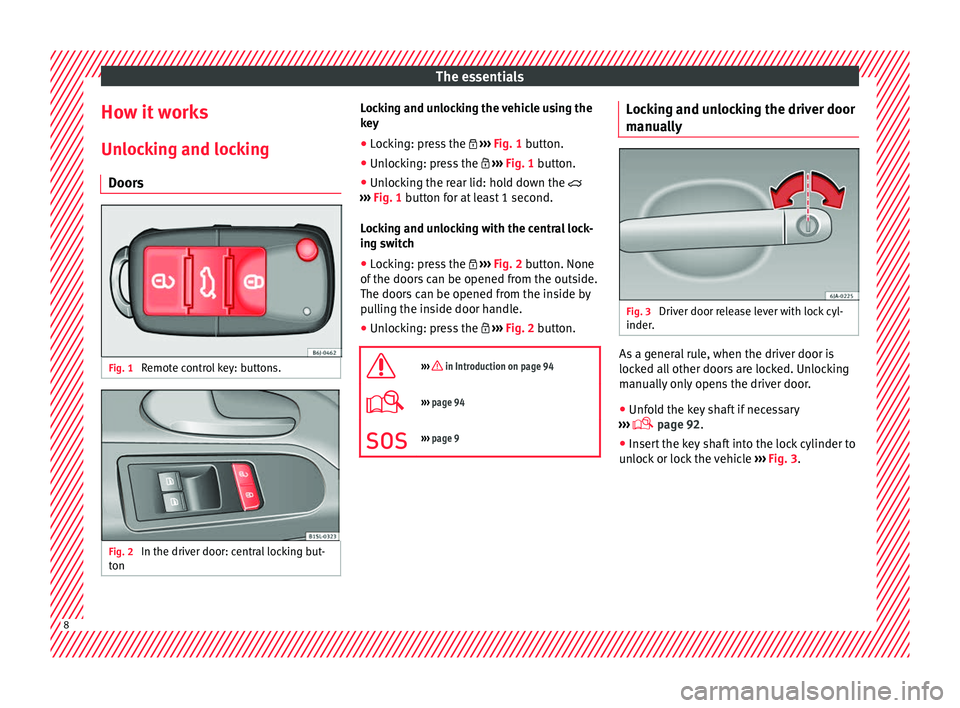
The essentials
How it works
Un loc
k
ing and locking
Doors Fig. 1
Remote control key: buttons. Fig. 2
In the driver door: central locking but-
t on Locking and unlocking the vehicle using the
k
ey
â Loc
king: press the ï½ âºâºâº
Fig. 1 button.
â Unlocking: press the ï¼ âºâºâº
Fig. 1 button.
â Unlocking the rear lid: hold down the ï²
âºâºâº
Fig. 1 button for at least 1 second.
Locking and unlocking with the central lock-
ing switch
â Locking: press the ï½ âºâºâº
Fig. 2 button. None
of the doors can be opened from the outside.
The doors can be opened from the inside by
pulling the inside door handle.
â Unlocking: press the ï¼ âºâºâº
Fig. 2 button.
ïª
âºâºâº in Introduction on page 94
ï©âºâºâº page 94
ïªâºâºâº page 9 Locking and unlocking the driver door
m
anua
l
ly Fig. 3
Driver door release lever with lock cyl-
inder . As a general rule, when the driver door is
loc
k
ed al
l other doors are locked. Unlocking
manually only opens the driver door.
â Unfold the key shaft if necessary
âºâºâº
ï© page 92.
â Insert the key shaft into the lock cylinder to
unloc
k or lock the vehicle âºâºâº Fig. 3.8
Page 11 of 232
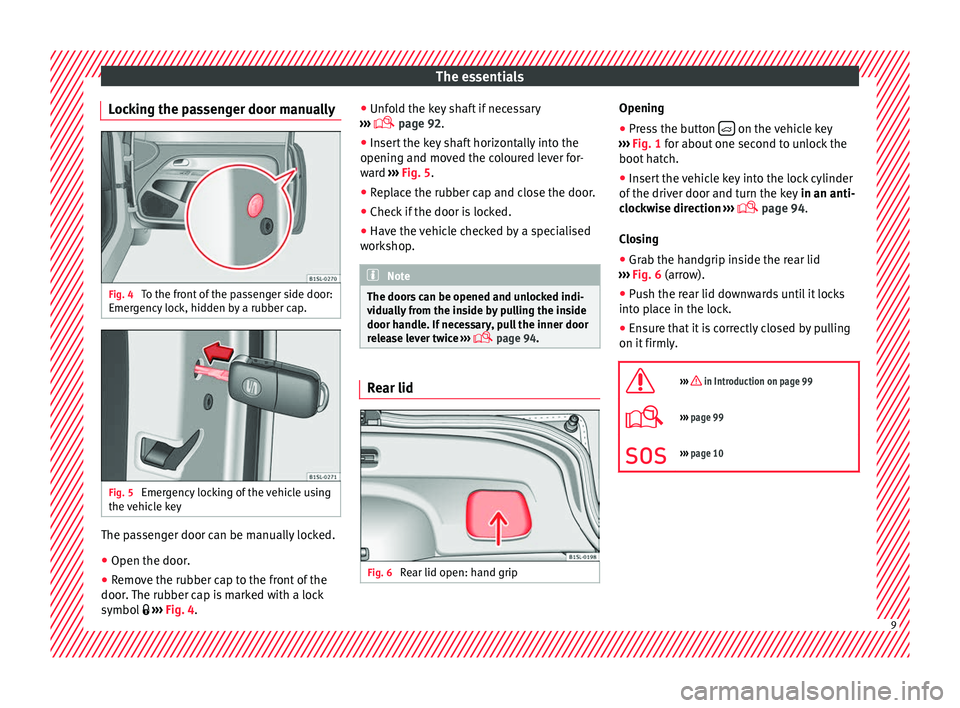
The essentials
Locking the passenger door manually Fig. 4
To the front of the passenger side door:
Emer g
ency
lock, hidden by a rubber cap. Fig. 5
Emergency locking of the vehicle using
the v
ehic
le key The passenger door can be manually locked.
â Open the door.
â Remove the rubber cap to the front of the
door .
The rubber c
ap is marked with a lock
symbol ï
âºâºâº Fig. 4. â
Unfol
d the key shaft if necessary
âºâºâº ï© page 92.
â Insert the key shaft horizontally into the
opening and mov
ed the coloured lever for-
ward âºâºâº Fig. 5.
â Replace the rubber cap and close the door.
â Check if the door is locked.
â Have the vehicle checked by a specialised
workshop
. Note
The doors can be opened and unlocked indi-
vidua l
ly from the inside by pulling the inside
door handle. If necessary, pull the inner door
release lever twice âºâºâº
ï© page 94. Rear lid
Fig. 6
Rear lid open: hand grip Opening
â Press the button ï² on the vehicle key
⺠âº
âº
Fig. 1 for about one second to unlock the
boot hatch.
â Insert the vehicle key into the lock cylinder
of the driver door and t
urn the key in an anti-
clockwise direction âºâºâº
ï© page 94.
Closing â Grab the handgrip inside the rear lid
âºâºâº
Fig. 6 (arrow).
â Push the rear lid downwards until it locks
into pl
ace in the lock.
â Ensure that it is correctly closed by pulling
on it firmly
.
ïª
âºâºâº in Introduction on page 99
ï©âºâºâº page 99
ïªâºâºâº page 10 9
Page 13 of 232

The essentials
â Pu
l
l the release lever 1 in the direction of
the arr o
w âº
âºâº Fig. 8 A. The bonnet is released
from the lock carrier by a spring mechanism
âºâºâº in Working in the engine compartment
on p ag
e 188
.
â Lift the bonnet up slightly while pressing
the rele
ase lever 2 B in the dir
ection of the
arr o
w to completely open the bonnet.
â Take out the bonnet support rod from its
clip in the direction of
the arrow 3 C and
p l
ac
e it in the corresponding open position
4 D (arr
ow).
C lo
sing the bonnet
â Slightly lift the bonnet âºâºâº
in Working in
the en gine c
omp
artment on page 188.
â Take out the bonnet support rod from the
opening cat
ch 4 D and in
sert it into its clip
3 C in the openin
g c
at
ch.
â Let the bonnet fall from a height of 30 cm
into its c
lip; Do not apply pressure!
If the bonnet is not correctly closed, open it
once again and close it correctly.
The bonnet is correctly closed when it is flush
with the corresponding parts on the body-
work.
ïª
âºâºâº in Working in the engine compart-
ment on page 186
ï©âºâºâº page 186 Electric windows*
Fig. 10
In the driver door: buttons for the
fr ont
el
ectric windows â
Opening the window: Press the ïµ butt
on.
â C
losing the window: Pull the ïµ button.
W
indow on the front left door
Window on the front right door
ïª
âºâºâº in Opening and closing the electric
windows on page 101 1
2 Panoramic sunroof*
Fig. 11
In the interior roof: turn the knob to
open and c lo
se Fig. 12
In the interior roof: press or pull the
kno b t
o r
aise the sunroof and close it. To raise the sliding/tilting sunroof, the knob
mu
s
t
be in the basic position 1 .
â Opening: Turn the switch to position
⺠âº
âº
Fig. 11 3 .
» 11
Page 24 of 232
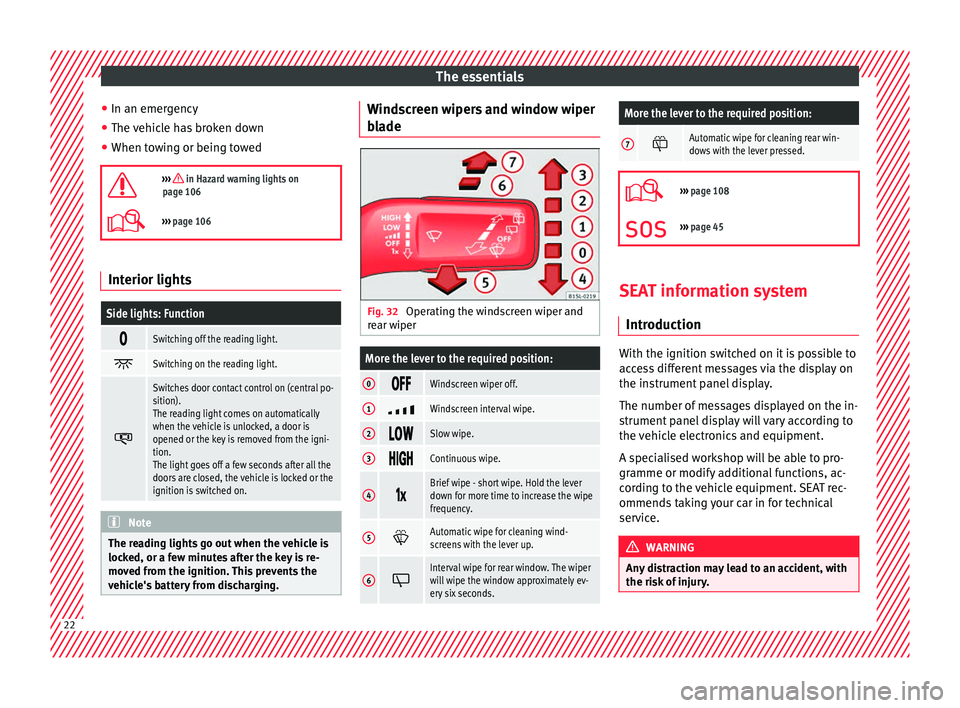
The essentials
â In an emer g
ency
â The
vehicle has broken down
â When towing or being towed
ïª
âºâºâº in Hazard warning lights on
page 106
ï©âºâºâº page 106 Interior lights
Side lights: Function
ï
Switching off the reading light.
ïº
Switching on the reading light.
ï´
Switches door contact control on (central po-
sition).
The reading light comes on automatically
when the vehicle is unlocked, a door is
opened or the key is removed from the igni-
tion.
The light goes off a few seconds after all the
doors are closed, the vehicle is locked or the
ignition is switched on.
Note
The reading lights go out when the vehicle is
lock ed, or a f
ew minutes after the key is re-
moved from the ignition. This prevents the
vehicle's battery from discharging. Windscreen wipers and window wiper
b
l
a
de Fig. 32
Operating the windscreen wiper and
r e
ar w
iper
More the lever to the required position:
0 ïïïWindscreen wiper off.
1
ïºWindscreen interval wipe.
2
ïïïSlow wipe.
3
ïïïïContinuous wipe.
4
ï±ï³Brief wipe - short wipe. Hold the lever
down for more time to increase the wipe
frequency.
5
ï·Automatic wipe for cleaning wind-
screens with the lever up.
6
ïºInterval wipe for rear window. The wiper
will wipe the window approximately ev-
ery six seconds.
More the lever to the required position:
7 ï¼Automatic wipe for cleaning rear win-
dows with the lever pressed.
ï©
âºâºâº
page 108
ïªâºâºâº page 45 SEAT information system
Intr oduction With the ignition switched on it is possible to
ac
c
e
ss different messages via the display on
the instrument panel display.
The number of messages displayed on the in-
strument panel display will vary according to
the vehicle electronics and equipment.
A specialised workshop will be able to pro-
gramme or modify additional functions, ac-
cording to the vehicle equipment. SEAT rec-
ommends taking your car in for technical
service. WARNING
Any distraction may lead to an accident, with
the risk of
injury.22
Page 63 of 232
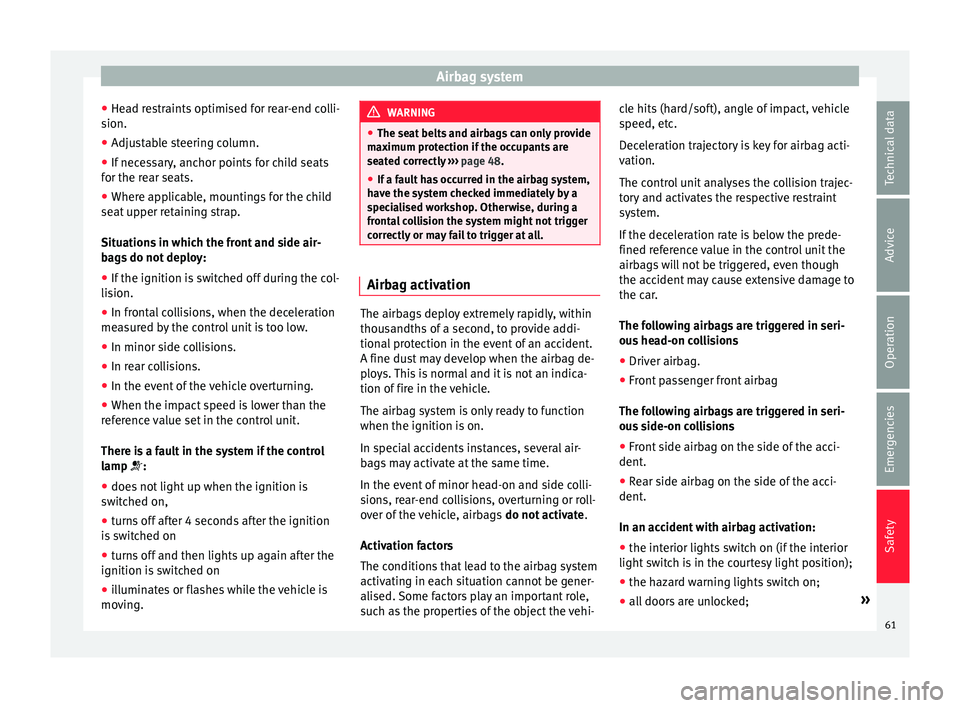
Airbag system
â He a
d r
estraints optimised for rear-end colli-
sion.
â Adjustable steering column.
â If necessary, anchor points for child seats
for the re
ar seats.
â Where applicable, mountings for the child
seat up
per retaining strap.
Situations in which the front and side air-
bags do not deploy:
â If the ignition is switched off during the col-
lision.
â In fr
ontal collisions, when the deceleration
meas
ured by the control unit is too low.
â In minor side collisions.
â In rear collisions.
â In the event of the vehicle overturning.
â When the impact speed is lower than the
refer
ence value set in the control unit.
There is a fault in the system if the control
lamp ï´:
â does not light up when the ignition is
switc
hed on,
â turns off after 4 seconds after the ignition
is sw
itched on
â turns off and then lights up again after the
ignition is sw
itched on
â illuminates or flashes while the vehicle is
movin
g. WARNING
â The seat belt
s and airbags can only provide
maximum protection if the occupants are
seated correctly âºâºâº page 48.
â If a fault has occurred in the airbag system,
have the sy
stem checked immediately by a
specialised workshop. Otherwise, during a
frontal collision the system might not trigger
correctly or may fail to trigger at all. Airbag activation
The airbags deploy extremely rapidly, within
thou
s
andths
of a second, to provide addi-
tional protection in the event of an accident.
A fine dust may develop when the airbag de-
ploys. This is normal and it is not an indica-
tion of fire in the vehicle.
The airbag system is only ready to function
when the ignition is on.
In special accidents instances, several air-
bags may activate at the same time.
In the event of minor head-on and side colli-
sions, rear-end collisions, overturning or roll-
over of the vehicle, airbags do not activate.
Activation factors
The conditions that lead to the airbag system
activating in each situation cannot be gener-
alised. Some factors play an important role,
such as the properties of the object the vehi- cle hits (hard/soft), angle of impact, vehicle
speed, etc
.
Deceleration trajectory is key for airbag acti-
vation.
The control unit analyses the collision trajec-
tory and activates the respective restraint
system.
If the deceleration rate is below the prede-
fined reference value in the control unit the
airbags will not be triggered, even though
the accident may cause extensive damage to
the car.
The following airbags are triggered in seri-
ous head-on collisions â Driver airbag.
â Front passenger front airbag
The fol
lowing airbags are triggered in seri-
ous side-on collisions
â Front side airbag on the side of the acci-
dent.
â Re
ar side airbag on the side of the acci-
dent.
In an acc
ident with airbag activation:
â the interior lights switch on (if the interior
light swit
ch is in the courtesy light position);
â the hazard warning lights switch on;
â all doors are unlocked; »
61
Technical data
Advice
Operation
Emergencies
Safety
Page 64 of 232
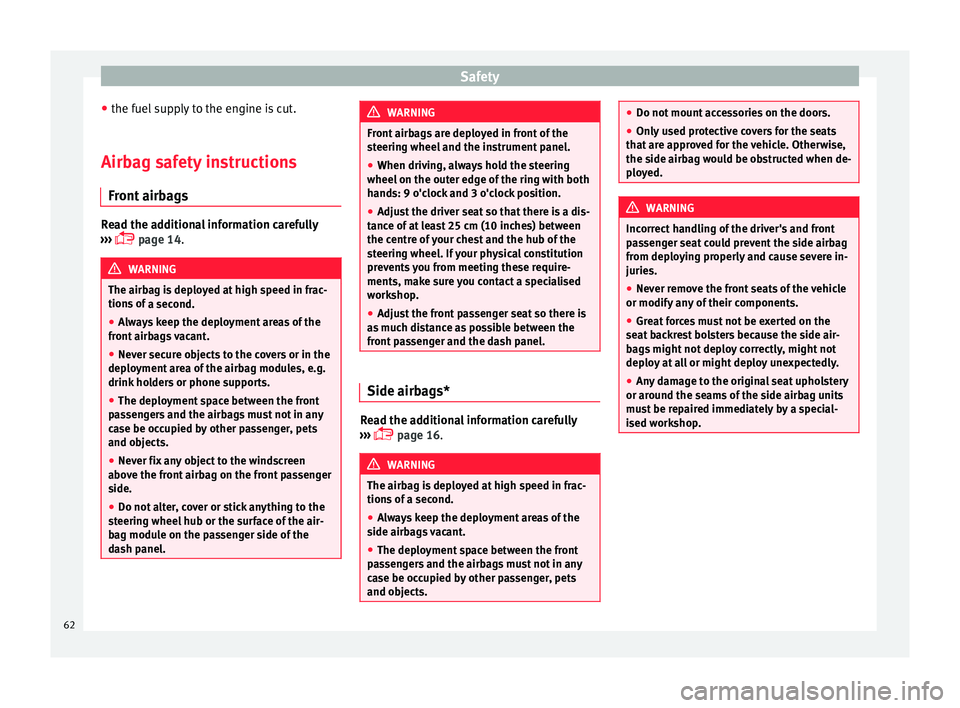
Safety
â the f uel
s
upply to the engine is cut.
Airbag safety instructions Front airb
agsRead the additional information carefully
âºâº âº
ï¨ page 14. WARNING
The airbag is deployed at high speed in frac-
tions of
a second.
â Always keep the deployment areas of the
front airb
ags vacant.
â Never secure objects to the covers or in the
deployment
area of the airbag modules, e.g.
drink holders or phone supports.
â The deployment space between the front
pas
sengers and the airbags must not in any
case be occupied by other passenger, pets
and objects.
â Never fix any object to the windscreen
above the fr
ont airbag on the front passenger
side.
â Do not alter, cover or stick anything to the
steerin
g wheel hub or the surface of the air-
bag module on the passenger side of the
dash panel. WARNING
Front airbags are deployed in front of the
st eerin
g wheel and the instrument panel.
â When driving, always hold the steering
wheel on the outer edg
e of the ring with both
hands: 9 o'clock and 3 o'clock position.
â Adjust the driver seat so that there is a dis-
tance of
at least 25 cm (10 inches) between
the centre of your chest and the hub of the
steering wheel. If your physical constitution
prevents you from meeting these require-
ments, make sure you contact a specialised
workshop.
â Adjust the front passenger seat so there is
as muc
h distance as possible between the
front passenger and the dash panel. Side airbags*
Read the additional information carefully
⺠âº
âº
ï¨ page 16. WARNING
The airbag is deployed at high speed in frac-
tions of
a second.
â Always keep the deployment areas of the
side airbag
s vacant.
â The deployment space between the front
pas
sengers and the airbags must not in any
case be occupied by other passenger, pets
and objects. â
Do not mou nt
accessories on the doors.
â Only used protective covers for the seats
that ar
e approved for the vehicle. Otherwise,
the side airbag would be obstructed when de-
ployed. WARNING
Incorrect handling of the driver's and front
p as
senger seat could prevent the side airbag
from deploying properly and cause severe in-
juries.
â Never remove the front seats of the vehicle
or modify an
y of their components.
â Great forces must not be exerted on the
seat b
ackrest bolsters because the side air-
bags might not deploy correctly, might not
deploy at all or might deploy unexpectedly.
â Any damage to the original seat upholstery
or around the se
ams of the side airbag units
must be repaired immediately by a special-
ised workshop. 62
Page 67 of 232
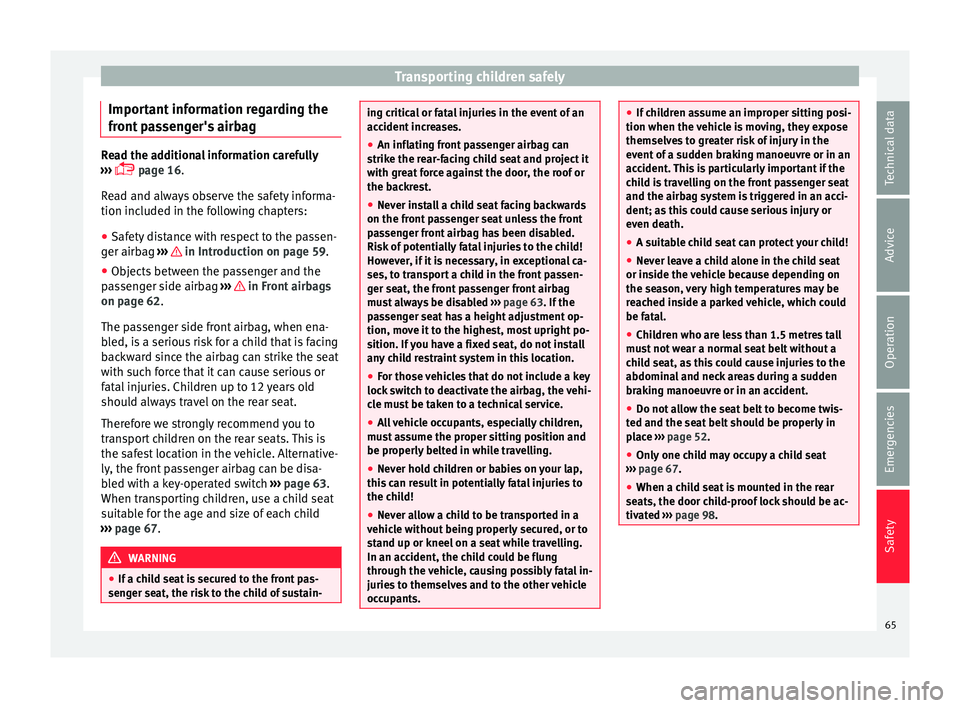
Transporting children safely
Important information regarding the
fr ont
p
assenger's airbag Read the additional information carefully
âºâº âº
ï¨ page 16.
Read and always observe the safety informa-
tion included in the following chapters: â Safety distance with respect to the passen-
ger airbag âº
âºâº in Introduction on page 59.
â Objects between the passenger and the
pa s
senger side airbag âºâºâº in Front airbags
on p ag
e 62
.
The passenger side front airbag, when ena-
bled, is a serious risk for a child that is facing
backward since the airbag can strike the seat
with such force that it can cause serious or
fatal injuries. Children up to 12 years old
should always travel on the rear seat.
Therefore we strongly recommend you to
transport children on the rear seats. This is
the safest location in the vehicle. Alternative-
ly, the front passenger airbag can be disa-
bled with a key-operated switch âºâºâº
page 63.
When transporting children, use a child seat
suitable for the age and size of each child
âºâºâº page 67. WARNING
â If a c hi
ld seat is secured to the front pas-
senger seat, the risk to the child of sustain- ing critical or fatal injuries in the event of an
acc
ident
increases.
â An inflating front passenger airbag can
strike the r
ear-facing child seat and project it
with great force against the door, the roof or
the backrest.
â Never install a child seat facing backwards
on the front p
assenger seat unless the front
passenger front airbag has been disabled.
Risk of potentially fatal injuries to the child!
However, if it is necessary, in exceptional ca-
ses, to transport a child in the front passen-
ger seat, the front passenger front airbag
must always be disabled âºâºâº page 63. If the
passenger seat has a height adjustment op-
tion, move it to the highest, most upright po-
sition. If you have a fixed seat, do not install
any child restraint system in this location.
â For those vehicles that do not include a key
lock sw
itch to deactivate the airbag, the vehi-
cle must be taken to a technical service.
â All vehicle occupants, especially children,
must
assume the proper sitting position and
be properly belted in while travelling.
â Never hold children or babies on your lap,
this c
an result in potentially fatal injuries to
the child!
â Never allow a child to be transported in a
vehicl
e without being properly secured, or to
stand up or kneel on a seat while travelling.
In an accident, the child could be flung
through the vehicle, causing possibly fatal in-
juries to themselves and to the other vehicle
occupants. â
If c hi
ldren assume an improper sitting posi-
tion when the vehicle is moving, they expose
themselves to greater risk of injury in the
event of a sudden braking manoeuvre or in an
accident. This is particularly important if the
child is travelling on the front passenger seat
and the airbag system is triggered in an acci-
dent; as this could cause serious injury or
even death.
â A suitable child seat can protect your child!
â Never leave a child alone in the child seat
or inside the
vehicle because depending on
the season, very high temperatures may be
reached inside a parked vehicle, which could
be fatal.
â Children who are less than 1.5 metres tall
must
not wear a normal seat belt without a
child seat, as this could cause injuries to the
abdominal and neck areas during a sudden
braking manoeuvre or in an accident.
â Do not allow the seat belt to become twis-
ted and the seat
belt should be properly in
place âºâºâº page 52.
â Only one child may occupy a child seat
âºâºâº
page 67.
â When a child seat is mounted in the rear
seats, the door c
hild-proof lock should be ac-
tivated âºâºâº page 98. 65
Technical data
Advice
Operation
Emergencies
Safety
Page 79 of 232
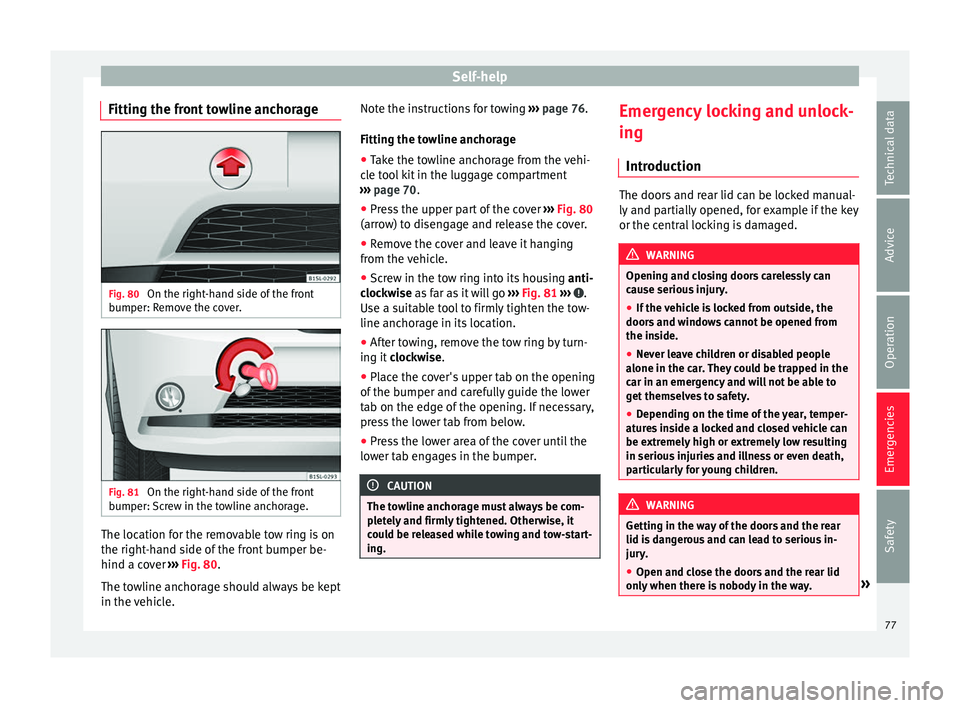
Self-help
Fitting the front towline anchorage Fig. 80
On the right-hand side of the front
b umper: R
emo
ve the cover. Fig. 81
On the right-hand side of the front
b umper: Sc
rew in the towline anchorage. The location for the removable tow ring is on
the right
-h
and s
ide of the front bumper be-
hind a cover âºâºâº Fig. 80.
The towline anchorage should always be kept
in the vehicle. Note the instructions for towing
âºâºâº
page 76.
Fitting the towline anchorage
â Take the towline anchorage from the vehi-
cle t
ool kit in the luggage compartment
âºâºâº page 70.
â Press the upper part of the cover âºâºâº
Fig. 80
(arrow) to disengage and release the cover.
â Remove the cover and leave it hanging
from the v
ehicle.
â Screw in the tow ring into its housing anti-
clock
wise as far as it will go âºâºâº Fig. 81 âºâºâº .
U se a s
uit
able tool to firmly tighten the tow-
line anchorage in its location.
â After towing, remove the tow ring by turn-
ing it c
lockwise.
â Place the cover's upper tab on the opening
of the bumper and c
arefully guide the lower
tab on the edge of the opening. If necessary,
press the lower tab from below.
â Press the lower area of the cover until the
lower t
ab engages in the bumper. CAUTION
The towline anchorage must always be com-
pl et
ely and firmly tightened. Otherwise, it
could be released while towing and tow-start-
ing. Emergency locking and unlock-
in
g
Intr oduction The doors and rear lid can be locked manual-
ly and p
ar
tially opened, for example if the key
or the central locking is damaged. WARNING
Opening and closing doors carelessly can
cau se seriou
s injury.
â If the vehicle is locked from outside, the
doors and w
indows cannot be opened from
the inside.
â Never leave children or disabled people
alone in the car
. They could be trapped in the
car in an emergency and will not be able to
get themselves to safety.
â Depending on the time of the year, temper-
ature
s inside a locked and closed vehicle can
be extremely high or extremely low resulting
in serious injuries and illness or even death,
particularly for young children. WARNING
Getting in the way of the doors and the rear
lid is d
angerous and can lead to serious in-
jury.
â Open and close the doors and the rear lid
only when ther
e is nobody in the way. » 77
Technical data
Advice
Operation
Emergencies
Safety
Page 89 of 232
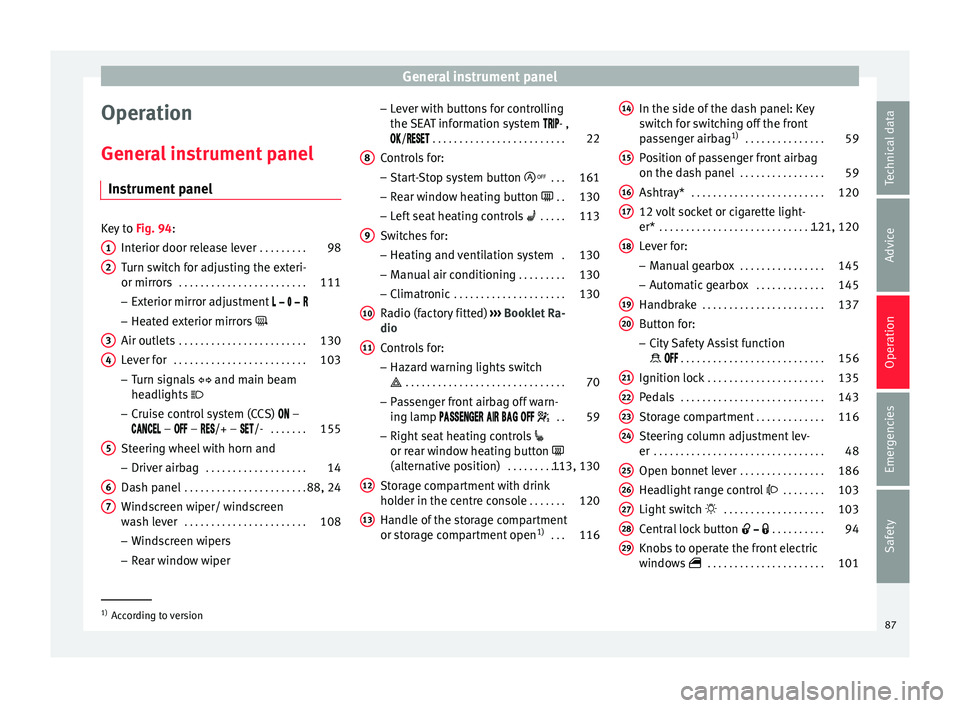
General instrument panel
Operation
Gener a
l
instrument panel
Instrument panel Key to
Fig. 94:
Interior door r el
ease lever . . . . . . . . . 98
Turn switch for adjusting the exteri-
or mirrors . . . . . . . . . . . . . . . . . . . . . . . . 111
â Exterior mirr or a
djustment ï ï ï° ï ï
â Heated exterior mirrors ï
Air outlets . . . . . . . . . . . . . . . . . . . . . . . . 130
Lever for . . . . . . . . . . . . . . . . . . . . . . . . . 103
â Turn sign
als ï® and main beam
headlights ï¤
â Cruise control system (CCS) ïï â
ïïïïï
ï â ïïï â ïï
ï/+ â ïï
ï/- . . . . . . .155
Steering wheel with horn and â Driver airb ag . . . . . . . . . . . . . . . . . . . 14
Da
sh panel . . . . . . . . . . . . . . . . . . . . . . . 88, 24
Windscreen wiper/ windscreen
wash l
ever . . . . . . . . . . . . . . . . . . . . . . . 108
â Wind s
creen wipers
â Rear window wiper
1 2
3
4
5
6
7 â
Lev
er w
ith buttons for controlling
the SEAT information system ïïïï- ,
ïï /ïï
ïï
ï . . . . . . . . . . . . . . . . . . . . . . . . . 22
Controls for:
â Start
-Stop system button ï¨ . . .161
â Rear w
indow heating button ï . .130
â Left
seat heating controls ï¡ . . . . . 113
Switches for: â Heating and
ventilation system .130
â Manual air c
onditioning . . . . . . . . . 130
â Clim atr
onic . . . . . . . . . . . . . . . . . . . . . 130
Radio (factory fitted) âºâºâº
Booklet Ra-
dio
Controls for:
â Hazard warning lights switch
ï¾ . . . . . . . . . . . . . . . . . . . . . . . . . . . . . . 70
â Pa s
senger front airbag off warn-
ing lamp ïïïïï
ïïï
ï ïïï ïïï ïïï ï¹ . .59
â Right seat
heating controls ï¦
or rear window heating button ï
(alternative position) . . . . . . . . . . .113, 130
Storage compartment with drink
hol der in the c
entre console . . . . . . .120
Handle of the storage compartment
or stor
age compartment open 1)
. . . 116
8 9
10
11
12
13 In the side of the dash panel: Key
sw
it
c
h for switching off the front
passenger airbag 1)
. . . . . . . . . . . . . . . 59
Position of passenger front airbag
on the dash p
anel . . . . . . . . . . . . . . . . 59
Ashtray* . . . . . . . . . . . . . . . . . . . . . . . . . 120
12 volt socket or cigarette light-
er* . . . . . . . . . . . . . . . . . . . . . . . . . . . . . . . 121, 120
Lever for:
â Manual g
earbox . . . . . . . . . . . . . . . . 145
â Autom atic
gearbox . . . . . . . . . . . . . 145
Handbrake . . . . . . . . . . . . . . . . . . . . . . . 137
Button for:
â City
Safety Assist function
ï½ ïïï . . . . . . . . . . . . . . . . . . . . . . . . . . . 156
Ignition lock . . . . . . . . . . . . . . . . . . . . . . 135
Pedals . . . . . . . . . . . . . . . . . . . . . . . . . . . 143
Storage compartment . . . . . . . . . . . . .116
Steering column adjustment lev-
er . . . . . . . . . . . . . . . . . . . . . . . . . . . . . . . . 48
Open bonnet lever . . . . . . . . . . . . . . . . 186
Headlight range control ï¦ . . . . . . . . 103
Light switch ï£ . . . . . . . . . . . . . . . . . . . 103
Central lock button ï ï ï . . . . . . . . . .94
Knobs to operate the front electric
window
s ï½ . . . . . . . . . . . . . . . . . . . . . . 101 14
15
16
17
18
19
20
21
22
23
24
25
26
27
28
29
1)
According to version
87
Technical data
Advice
Operation
Emergencies
Safety